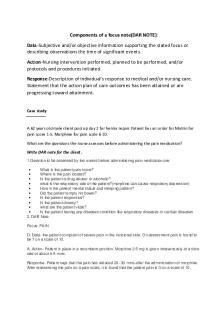DAR Wound Charting PDF

| Title | DAR Wound Charting |
|---|---|
| Author | AS AS |
| Course | Complex Nursing Care |
| Institution | University of Windsor |
| Pages | 2 |
| File Size | 104.4 KB |
| File Type | |
| Total Downloads | 99 |
| Total Views | 156 |
Summary
Download DAR Wound Charting PDF
Description
D.A.R. Charting: Data Action Response D: DATA – (Document objective and subjective assessment DATA) Suggestions for documentation of wound assessment: Pain (PQRST) Anatomical location: right/left, upper/mid/lower, anterior/posterior, arm/leg (etc), distal/proximal, at/near body line (axillary, scapular, spine, midline) Type: Incision, abrasion, puncture, laceration, ulcer, partial thickness, full thickness skin breakdown, wound stage. Drainage on Removed Dressing: amount and characteristics of drainage. Colour – sanguineous, serous, Serosanguineous, purulent, Measurement of wound: with a ruler in cm - measure: length, width, depth, (consider a documenting with a drawing). Measure depth with a saline moistened q-tip. Approximation: Well/poor, sutures/staples/steri-strips, appearance of wound edges, wound borders: red/pink (width), irregular. Appearance of wound base: undermined, tunneling, presence of eschar (dark brown-black) determine how much (%) eschar covers the wound base. Presence of slough- colour (yellow/tan) Odour: strong/faint, foul/non-offensive Peri-Wound Appearance: ecchymosis, abrasions, colour/ location Drains: type, location, how secured, drainage A: ACTION – (Document what interventions you did to help the pt. this is the ACTION) Document what you did during the dressing change Dressing change completed using sterile or clean technique. Identify solutions and medications applied and dressing materials applied (i.e. iodasorb ointment applied to wound base, wound base covered with 4 x4’s and abdominal pads.) Indicate how dressing was secured: tape, transparent dressing, gauze wrap, Montgomery straps, tensor wrap. Also, identify any teaching you did with patient. R: Response – (Document the pt’s response and effectiveness of interventions) How did patient tolerate the procedure, what was their understanding of teaching provided? Evaluation of pain, understanding of teaching. Pt. tolerated procedure well, denies pain at this time. Pt. stated understanding of teaching.
Wound DAR
Sample D.A.R. Charting Focus: Wound assessment and dressing change. Time D: –Pt. described pain at right upper arm wound site as “sharp, stabbing pain”, rated as 6/10 on pain scale. Small amount of Serosanguineous drainage was present on removed dressing. Wound base measured: 4 cm length x 0.5cm width x 0.5cm depth. Wound base had small amount of serosanguineous, purulent drainage with foul odour present. Wound base beefy red in colour. Wound edges reddened and irregular. Surrounding peri-wound area was intact with purple ecchymosis present 1-3cm wide. ---Do not skip line here A: Prior to dressing change, patient received PRN analgesia for stated pain at incision site (see MAR). Per physicians orders, dressing covering incision to upper, anterior aspect of right arm was removed. Using sterile technique, wound was cleansed with sterile 0.9 NS irrigation and peri-wound area was dried with gauze. Wet to dry gauze dressing was applied and secured with tape. Teaching re: signs and symptoms of infection were provided to patient. Patient was encouraged to call for assistance using call bell. ---------------------------------------------------Do not skip line here R: Patient tolerated dressing change well. Stated “pain is getting better” and rated pain 2/10 post dressing change. Patient also stated understanding of the need to use call bell for assistance. Will continue to monitor pain and patient needs ----------Signature SCCNS2/ Instuctor signature.
**All documentation must be co-signed by Instructor. It is the student’s responsibility to make sure all documentation has been co-signed before you leave the unit.
Wound DAR...
Similar Free PDFs

DAR Wound Charting
- 2 Pages

Final Charting
- 3 Pages

Wound-Dressing - WOUND DRESSING
- 3 Pages

Example Narrative charting
- 2 Pages

Wound Care
- 1 Pages

N3614 SOAP Charting 2017
- 2 Pages

Patient C - dental charting
- 2 Pages

Hltenn 006 wound management
- 12 Pages

Wound modules skin care
- 2 Pages

Wound CARE FOR Diebetics
- 3 Pages

Sim Chart Charting Day 1
- 1 Pages

Wound infection Concept Map
- 1 Pages

Wound Care Validation Notes
- 2 Pages
Popular Institutions
- Tinajero National High School - Annex
- Politeknik Caltex Riau
- Yokohama City University
- SGT University
- University of Al-Qadisiyah
- Divine Word College of Vigan
- Techniek College Rotterdam
- Universidade de Santiago
- Universiti Teknologi MARA Cawangan Johor Kampus Pasir Gudang
- Poltekkes Kemenkes Yogyakarta
- Baguio City National High School
- Colegio san marcos
- preparatoria uno
- Centro de Bachillerato Tecnológico Industrial y de Servicios No. 107
- Dalian Maritime University
- Quang Trung Secondary School
- Colegio Tecnológico en Informática
- Corporación Regional de Educación Superior
- Grupo CEDVA
- Dar Al Uloom University
- Centro de Estudios Preuniversitarios de la Universidad Nacional de Ingeniería
- 上智大学
- Aakash International School, Nuna Majara
- San Felipe Neri Catholic School
- Kang Chiao International School - New Taipei City
- Misamis Occidental National High School
- Institución Educativa Escuela Normal Juan Ladrilleros
- Kolehiyo ng Pantukan
- Batanes State College
- Instituto Continental
- Sekolah Menengah Kejuruan Kesehatan Kaltara (Tarakan)
- Colegio de La Inmaculada Concepcion - Cebu


